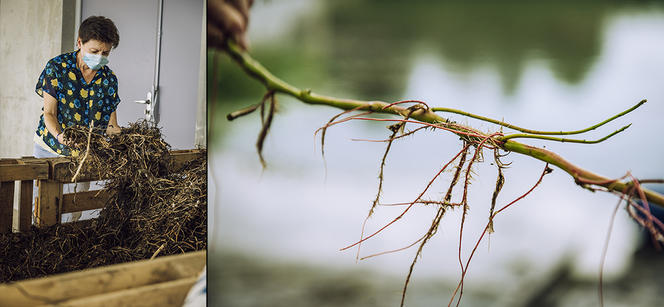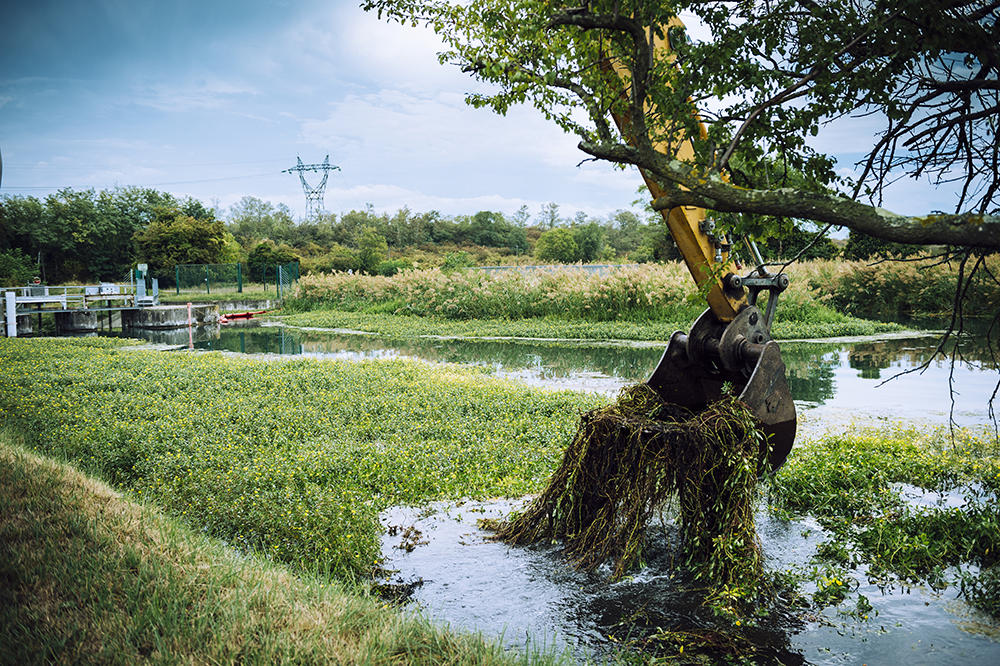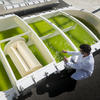You are here
Claude Grison, bio-inspired green chemist

Welcome to New Caledonia, with its enchanting lagoon, its fabulous reefs, its palm-lined beaches – and its soils devastated by mining. As the world's fifth-largest producer of nickel, the archipelago is paying a heavy environmental toll for this industry. An area of twenty thousand hectares of land is so degraded and polluted that it looks like Mars. Heavy rainfall and tropical cyclones batter this parched, stony ground, washing the pollutants down to the rivers and the lagoon, endangering the coral reefs. Until recently, no satisfactory solution had been found to this disastrous situation. But at Thio, 120 kilometres north of the capital Noumea, a mining site once considered barren is gradually coming back to life. And it's all thanks to Claude Grison, a CNRS researcher and director of the ChimEco bio-inspired chemistry and ecological innovations laboratory.1



At this experimental site, Grison is trialling a revolutionary idea. She is using metal-tolerant plant species to clean up the area and let nature take its course again, all while preventing toxic pollution from flowing into the lagoon. Better still, Grison, who was awarded the CNRS Innovation Medal in 2014, has turned the environmental restoration of this former open-cast mine into a profitable activity by harvesting the metal-rich plants and recycling them, ushering in an entirely new concept in green chemistry.
Combining research and teaching
Claude Grison was born in 1960 to a father who was a writer and a mother who worked in the civil service as a bank clerk, in Verdun (northeastern France). The town is bordered by forests which, as a child, she never tired of exploring on foot and by bike. From an early age, she showed an interest in every aspect of science, and dreamt of becoming a maths teacher. Finally, however, at the nearby University of Nancy, she opted for chemistry, which, as she puts it, is “a subject that lies at the crossroads of several disciplines: it is closely related to physics and requires the use of many mathematical tools, but it also forms an integral part of the study of life via biochemistry and organic chemistry. And in order to express yourself correctly, describe your research and put things into perspective, you have to blend all this with a little literature and philosophy. It's actually a rather central discipline.”

In 1987 Grison obtained her PhD, “in straight organic chemistry”, then followed this up with a postdoc in the private sector, on an industrial site owned by the French energy giant Total. The experience proved so positive that she was tempted to go into research and development (R&D). “It was a difficult choice, but in the end I came back to basic research and higher education.” In 1994, she joined the biomolecular organic chemistry laboratory in Nancy, which she co-headed until 2003, while being appointed a professor – one of the youngest in France – at the University of Nancy.
Her initial research focused on a subject at the interface between chemistry and biology, namely the mechanisms that enable bacteria to develop resistance to antibiotics and become virulent. When such microorganisms are attacked by an antibiotic, they not only try to resist, but also deploy remarkable defence and adaptation strategies. Understanding such processes at the molecular level is critical to developing new therapeutic approaches, especially when dealing with multidrug-resistant bacteria.
In 2003, she accepted a transfer and became deputy director of the biomolecular chemistry laboratory in Montpellier (southern France). There she continued her research into bacteria and, two years later, discovered the mechanism of an enzyme that plays a major role in antibiotic resistance. “When you see that, you can only marvel at the chemistry of nature. In order to adapt and resist, bacteria come up with extraordinary solutions, such as setting up a sort of molecular shield. It makes you feel rather humble,” she admits.
Curiosity aroused
The turning point in her career came in 2007, when four students in a preparatory class at the Montpellier-based Lycée Joffre whom she had met as part of a supervised personal initiative project,2 asked her whether plants could be used to clean up polluted soil. Grison was forced to admit that she had no idea. But her curiosity had been aroused, and she started to work her way through all the available scientific literature. She soon discovered that there was no effective method for remediating degraded land of the kind frequently left behind by mining operations. “There were only two options: either excavate the contaminated soil and treat it at an industrial site using aggressive chemical processes that, in turn, produce toxic waste; or try to contain the pollution to prevent it from spreading, which poses long-term problems of water infiltration and groundwater contamination.” There was clearly a crying need for the development of new restoration strategies.

It turned out that some ecologists had identified plants able to grow in highly metal-rich environments so polluted that no other species could survive there. In France, such ultra-resistant plants include the Alpine pennycress (Noccaea caerulescens) and the kidney vetch (Anthyllis vulneraria). They accumulate such huge amounts of pollutants in their leaves that you would expect them to die quickly, and yet they thrive quite happily. Could they hold the key to remediating contaminated sites?
A change of direction
Grison became so fascinated by the idea of using these plants to clean up pollution that, in 2008, she took a radical decision. She left her job as a lab director, abandoning a ready-made career, and joined the CEFE research centre in ecology and evolutionary ecology,3 where at the time she was the only chemist.
She was also to meet José Escarré, an ecologist who had described the properties of one of these plants a few years earlier. When she asked him whether this species could be used to clean up disused mining sites, the answer was clear-cut: “Certainly not. This plant is dangerous”. By extracting pollutants from the soil, it could endanger the surrounding ecosystem. What would happen if its metal-rich leaves were eaten by herbivores or caterpillars, or broken down by detritivores? This would pose a threat to the health and survival of animals, especially those at the top of the food chain, humans included.
However, Grison was not to be put off. There had to be a way of making use of these unique plants. It was then that she came up with a brilliant idea that was to change the course of her career. Rather than viewing these toxic leaves as hazardous waste, how about trying to recycle them? The metals they accumulate (zinc, copper, nickel, manganese, etc.) could form the basis of a new kind of chemistry.
A circular economy for chemical elements
Whoever did practical chemistry work at school knows that many reactions only take place in the presence of a catalyst. These are often metallic elements that enable various chemical compounds to react together. So, Grison thought, why not recover these metals from plants grown on polluted sites? Recycling them in this way would not only help to make decontamination sustainable, but also make it possible to produce a whole range of molecules for use in industry in an environmentally-friendly manner, thus ushering in a kind of circular economy for chemical elements.

Putting this idea into practice was a slow, painstaking process. “We took a fresh look at all the major mechanisms of organic chemistry that could be carried out using our plant-based catalysts,” she recalls. In 2009, after much trial and error, her team finally reached their goal. The processes they had developed enabled them to extract metals from the leaves and synthesise valuable molecules, without using solvents or toxic reagents, nor producing harmful waste or consuming excess energy. A way of contributing to the move towards the green, eco-friendly chemistry that first emerged in the 1990s and is now gradually gaining ground in the chemical industry.
“Absurd”, “far-fetched”, “ludicrous”
In 2010, Grison finally had the opportunity to try out her ideas in New Caledonia, where she had been sent by the CNRS and the French National Museum of Natural History. She knew that the archipelago was struggling to contain metal pollution from disused mining sites. As it happens, New Caledonia's flora includes a wide range of metal-tolerant species, such as a tree that can accumulate so much nickel that its sap turns blue.4
The researcher decided to launch a pilot mine reclamation project. She contacted a mining company and managed to capture their interest. She then went in search of funding, a thankless task when proposing such an unorthodox project. “Absurd”, “far-fetched”, and “ludicrous” were just some of the epithets she was met with. She persevered nonetheless, and from 2010, with the help of the CNRS and the French National Research Agency (ANR), managed to set up several experimental sites covering a total area of six hectares.
The project's goal was to transform barren land into an ecosystem as similar as possible to the island's natural vegetation. “We've already successfully grown four or five different species on these sites, including trees. It's quite an impressive sight: we started off with small 10 cm seedlings and 18 months later, they were taller than us,” Grison says proudly.
Researcher and entrepreneur
Since her experimental work in New Caledonia, Grison's career has taken off. She joined the CNRS as a researcher, and now heads the ChimEco laboratory, which she founded in 2014. She has filed 35 patents in just a few years, and set up two companies to develop ecocatalysts® made from plants harvested from polluted land.

The first of these is called Bioinspir and markets a wide range of molecules of interest to the pharmaceutical, industrial and cosmetics industries. One of them is highly prized by perfumers as it recreates the smell of jasmine. “The conventional processes for synthesising it are laborious, generate waste and rely on solvents from petrochemicals. As it turns out, we have successfully used our ecocatalysts® to produce the molecule at a competitive price via a zero-waste system,” she says. In all, Bioinspir currently sells around sixty chemical compounds. Her second company, called Laboratoires de Bioprotection, markets a natural mosquito repellent, Crusoe, which is available in pharmacies and on the Internet.
Killing three birds with one stone
After dealing with soils, Grison turned her attention to polluted waters in 2016. She showed that certain invasive aquatic plants such as floating primrose-willow (Ludwigia peploides) can be used to treat effluents contaminated by metals. At Bioinspir she then developed filters made from Ludwigia ground down to a powder. With these totally bio-based plant filters, Grison has succeeded in killing three birds with one stone: controlling the proliferation of an invasive species that is choking wetlands and aquatic environments all over France; cleaning up these water bodies by removing metal pollutants, including palladium and rare earths; and reusing these metals as ecocatalysts®, thus contributing to the development of green, sustainable chemistry.



Her discoveries, patents and research methods have earned her numerous prizes, the latest of which was the European Inventor Award 2022. “From a personal point of view, it's gratifying to receive awards. But what really matters is the recognition of an approach that shows that chemistry and environmental protection can go hand in hand. Ecological science and chemistry are still too far apart. Their two communities snub each other and have no intention of working together. And yet it's possible, as my team and I have shown,” points out Grison, who has also found the time to take on another mission. With the help of her daughter, a science journalist, she is reaching out to the general public to explain the positive role of science in general and of chemistry in particular, when it touches on nature. “Today there is a real sense of eco-anxiety driven by everything you hear on the news. I can see it in the young people who work in my lab. So it's important to share positive examples as well,” she concludes.
- 1. CNRS.
- 2. Supervised personal initiative work (TIPE) is included in the programme of scientific preparatory classes. Students are invited to consider a scientific and technical research topic, take initiatives, structure a project and work in groups.
- 3. CNRS / EPHE / IRD / Université de Montpellier.
- 4. Silvery-white metal which, in the form of nickel sulfate, takes on a blue colour. It is a key ingredient of stainless steel.



















